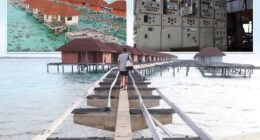A GIANT 36ft stealth submarine drone dubbed the “Blue Whale” has been deployed in the Baltic Sea to prevent any looming sabotage attacks.
Suspicions have been aroused concerning potential disruptions in the deep sea by Russia’s Vladimir Putin and China’s Xi Jinping following several instances of critical underwater cables being cut in recent months.




The huge drone is set to patrol across European waters on behalf of Nato after being released by the Germany navy.
The autonomous Blue Whale’s goal is to carry out deep sea surveillance in the Baltic Sea.
Its capabilities also include the ability to detect and pursue suspicious vessels as well as mines linked to foreign interference.
German navy officer Jan Christian Kaack has stated that they will face “high-performance weapons from potential adversaries, some of which are incredibly challenging to defend against.”
The drone, designed by the Israeli defence firm Elta, weighs a whopping five and a half tonnes and can move at 8mph in the water to stalk its target.
It is even capable of reaching depths as low as 984ft.
Elta say it can be used to “enhance naval operations with unprecedented levels of stealth and data fidelity”.
The data will be recorded and sent back to Navy officials on land through a complex “Synthetic Aperture Sonar” and a “Flank Array Sonar”.
These will capture high-resolution images of the seafloor and any other suspicious objects or vessels.
It is believed to be able to stay submerged for up to 30 days, report The Telegraph.
The German military first carried out test launches of the Blue Whale back in December, according to the Maritime Executive magazine.
Johannes Peters, a specialist from the Institute for Security Policy at Kiel University, explained to Spiegel magazine that “Underwater drones such as the Blue Whale will enable the German navy to significantly enhance monitoring of the Baltic Sea and spotting submarines, without the need for costly manned systems.”
The sub has reportedly been deployed in the wake of recent fears over alleged Chinese and Russian interference in European waters.
At the start of January potential Chinese sabotage was reported after a deep sea cable was cut off the coast of Taiwan.
A telecommunications cable was reportedly damaged near Yehliu, New Taipei City.
Taiwan’s Coast Guard was called in to investigate after discovering four cores of the international cable had been mangled.
A Cameroon-registered cargo ship known as the Shunxin 39 was blamed for causing the damage, according to Taiwan’s National Coast Guard Administration.
Despite the ship sailing under a Cameroonian flag, Taiwanese officials believe it is owned by China and registered in Hong Kong.
Taiwanese authorities are understood to be concerned that the move could be the start of secret operations to cut off external communications.
This could lead to the country being separated from the rest of the world and vulnerable to a Chinese invasion.




Beijing has constantly claimed sovereignty over the island has spent years threatening to seize it by any means necessary.
Last year, a Chinese bulk carrier was also placed under investigation by Swedish authorities after two fibre-optic cables in the Baltic Sea were damaged.
Investigators suspected the Yi Peng 3 was responsible after tracking data showed it leaving the Russian port of Ust-Luga on November 15.
A third incident took place again in January 2025 after Russia was also accused of sabotage in the Baltic Sea – prompting the move to deploy the Blue Whale.
A Russian ship allegedly cut a key Finish power cable with its anchor.
The Russian vessel was accused of dragging its anchor on the seabed for dozens of miles.
The Estlink 2 power cable in the Gulf of Finland was ruptured along with four other communication lines in the suspected deliberate act of vandalism.
Officials believe the ship was a 751ft Eagle S part of Russia’s “shadow” or “dark” fleet operated by Putin to evade sanctions.
A Chinese vessel was also seen in the area at the time of the incident.
Since the invasion of Ukraine almost three years ago, Russia have been using hybrid warfare tactics to get to their enemies.
This has typically targeted nations who have strongly backed Ukraine such as Germany.
This has involved targeting critical infrastructure, such as undersea cables.


















